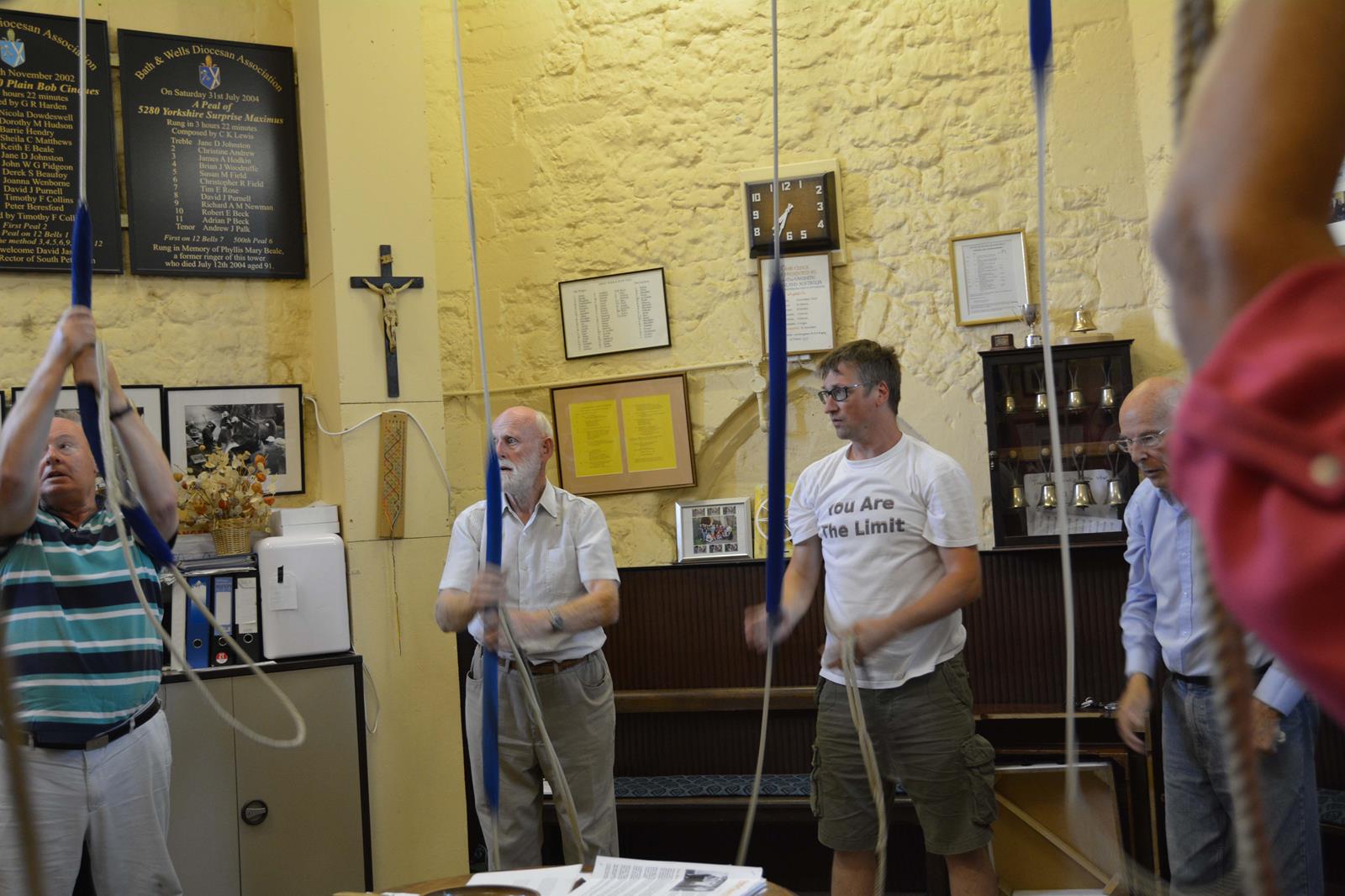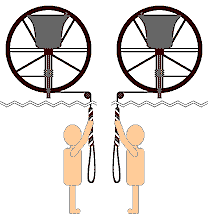Using a Ringing Simulator to Teach Ringing
by John Heaton, of Derby Cathedral
Ringing simulators can be used to demonstrate to new ringers what ringing should sound like in a way which may be better than listening to real ringing by a moderate band. Many learners seem to believe what they see rather than what they hear, therefore they like to look at ropes more than they like to listen to bells and they will believe a computer which tells them that their striking is off more easily than they will believe a human. Although people prefer to use their sight rather than their hearing, listening skills are, in the end, more important to good striking and it's what the ringing sounds like that matters. The following is a suggested series of steps that instructors may follow in order to develop listening skills in their learners.
Hearing Your Own Bell
The first difficulty to overcome is to learn that a bell doesn't ring until some time after it is pulled. In fact it rings near the end of its swing, just as the ringer's hands are rising past his face. Practice at ringing a single bell and making this connection can, of course, be done on an ordinary open bell but the advantage of a simulator is that this can be done silently.
The learner should ring the bell and make the connection between when the rope is pulled and when the bell strikes, anything up to 2 seconds later. This should be solidly understood before progressing.
The next step is to add another bell, generated by the simulator, and to get the learner to be able to distinguish the sound of his bell from that of the additional bell. The additional bell may be higher or lower in pitch than the learner's and the learner should eventually be able to hear which bell is which.
Next, add a third bell so that the learner's bell might be any of the three. Then add a fourth bell...
At each stage get the learner to change speed and listen to the affect on the sound. The learner must be able to recognise whether his bell is in the right place, ringing too soon or ringing too late.
Much of this can be done on open bells but with the simulator you will be able to get the learner to listen to bells without seeing ropes and therefore to get used to knowing which of the bells is his by the sound.
Leading And Basic Rhythm
Assuming that the learner has had some introduction to ringing Rounds on real bells it's probably easiest for them to start ringing Rounds on the simulator by ringing the Treble. The Treble is the lightest bell and, as the highest in pitch, is easy to pick out. The Tenor may be equally easy to hear but, as the heaviest bell, it is more difficult to handle than the Treble. If the simulator has just one bell with a sensor then set this to be the Treble.
The learner will have been told about leaving a gap at handstroke but to reinforce this idea get the simulator to ring some Rounds for the learner to listen to. Alter the size of the handstroke gap so that the learner can hear what the correct (for your band) gap should sound like.
Next, let the learner ring the Treble to some Rounds on 6. The points to stress here are that the handstroke is rung noticeably more slowly than the backstroke and that it takes a bit of effort, concentration and bell control to get it right. Learners are generally amazed by the difference in speeds of the handstroke and the backstroke.
It is important that the learner also rings the Treble to proper Rounds and learns to realise that the quality of the ringing is reduced by poor leading possibly more than by any other cause. If the real ringing is compromised by other inexperienced ringers then the simulator exercise should be repeated.
Once the learner can lead correctly then he can move on to the next stage.
Rounds On An Inside Bell
 The learner is ready to attempt Rounds on an inside bell once he has mastered leading and can reliably hear is own bell and correct any deviations from the correct rhythm.
The learner is ready to attempt Rounds on an inside bell once he has mastered leading and can reliably hear is own bell and correct any deviations from the correct rhythm.
It should be stressed that the rhythm that applies to leading (slow handstroke, quick backstroke) also applies to ringing each of the other bells.This rhythm must pervade the whole of the ringing. With this in mind the learner will be able to fall into the basic rhythm quite easily.
The main purpose of this exercise is to get the learner to be able to hear his bell amongst the others when it isn't a particularly prominent one. Thus it is advised that the learner has a try at each bell until he can not only hear that his bell is in the right place but also, should it wander off, whether he needs to ring quicker or slower. When something goes wrong ringers fall into either of two groups: those that speed up and those that slow down.
As the learner rings different bells he should be made aware that the lightest bells ring to the balance and the heaviest don't. Learners can get the idea that because they were taught how to ring to the balance they must always do so. It is also worth adding some odd-struckness and getting the learner to deal with it.
In order to develop the sense of the length of the delay between pulling a bell and its striking set the simulator to ring Rounds and, once they are going, get the learner to join in, judging when to pull off by listening to the simulated bells.
Covering
Covering is an art in itself. All too often a learner is made to cover too soon, before their sense of rhythm is sufficiently well developed and before they can even hear or see 6ths (or higher) place. Bad covering will completely ruin otherwise good ringing and the learner will probably be aware of this, ending up embarrassed and discouraged.
Covering is all about rhythm and setting a good speed for the rest of the band. The ability to hear this rhythm is vital and can be achieved as follows: The tenor should be kept moving and its rope should be given its main pull when the bell in some particular position is supposed to ring, according to the following, experimentally derived, table:
Number of Bells Listen for Bell in
6 2nds
8 3rds
10 4ths
12 5ths
If this is done, with allowances for odd-struckness in the tenor, the covering will be of high quality. Modesty prevents me from repeating the comments made by the judge after once using this covering technique in the National 12-Bell Striking Competition!
 Dodging
Dodging
Dodging practice is a very good way of developing and extending the sense of rhythm and also develops bell handling skills. The sense of rhythm is developed as the feel of the speed changes is acquired. Bell handling must be developed so that the learner knows how not to pull too hard if the next stroke is to be quick or to pull harder if the next stroke is to be slow. Also, the learner should be taught to catch the sally in different places and move up and down the tail end.
Start on 6 bells. Define a method with the place notation xx. This makes all the bells dodge in pairs. When rung by the simulator the "Stop at Rounds" setting must be off otherwise the whole thing will last 2 blows. Get the learner to ring an odd numbered bell to practice "up" dodges and an even numbered bell for "down" dodges. It is worth the learner's time to ring all the bells to get used to the sound of dodging in different places and to get used to dodging with bells of different weights.
The learner will be amazed at the difference in speed between the handstroke and backstroke. The exercise should be repeated on 8, 10 and 12 bells to show that as the number of bells increases the speed differences decrease.
Hunting
Plain hunt should be rung first on 6 bells (maybe 5 with a cover) and then on higher numbers. The learner should first ring the Treble so that his bell is easily picked out and then move to other bells.
Usually at the first attempt the learner will not slow down enough to reach the higher places but will not speed up enough when hunting down and so will end up back in 1st place at the right time. In particular the backstrokes
will be too quick when hunting up and too slow when hunting down. Some learners get the idea that the backstroke doesn't really count, it being simply the means of getting back to handstroke. If all this is true of a learner then the simulator's striking window should convince them that they need to work on these things.
Once ordinary hunting has been mastered the learner should attempt hunting between positions other than 1st and last. For example, in St. Clements Minor, bells hunt between 3rds and 6ths. A method with the notation x36x36x36x36 could be used to practice this. Learners have difficulty with the idea of turning round in places other than 1st place so this is very useful practice.
Ringing A Method
Once the basic skills of dodging and hunting (plus whatever other exercises seem appropriate) are mastered they can be put together into a method. Plain Bob will exercise the leading, hunting and dodging skills. St. Clements and St. Simons will exercise the turning round in 3rds skills. Other methods should be used to try other skills.
Whatever methods are used the emphasis should be on the learner becoming "self sufficient" as far as his need to see where bells such as the Treble are. A ringer who must see where the Treble is in order to know what his next dodge is a liability and ringers who have been taught to ring this way have been badly taught. The use of the simulator to get learners to remember where they are, because the opportunity to see the Treble is absent, should be very useful in producing reliable ringers.
It is assumed in the notes that the learner will be having normal ringing lessons and will have had the normal terminology explained. Therefore this isn't a complete course on learning to handle and strike but is merely a suggested programme for the reinforcement of such a course on a simulator.
